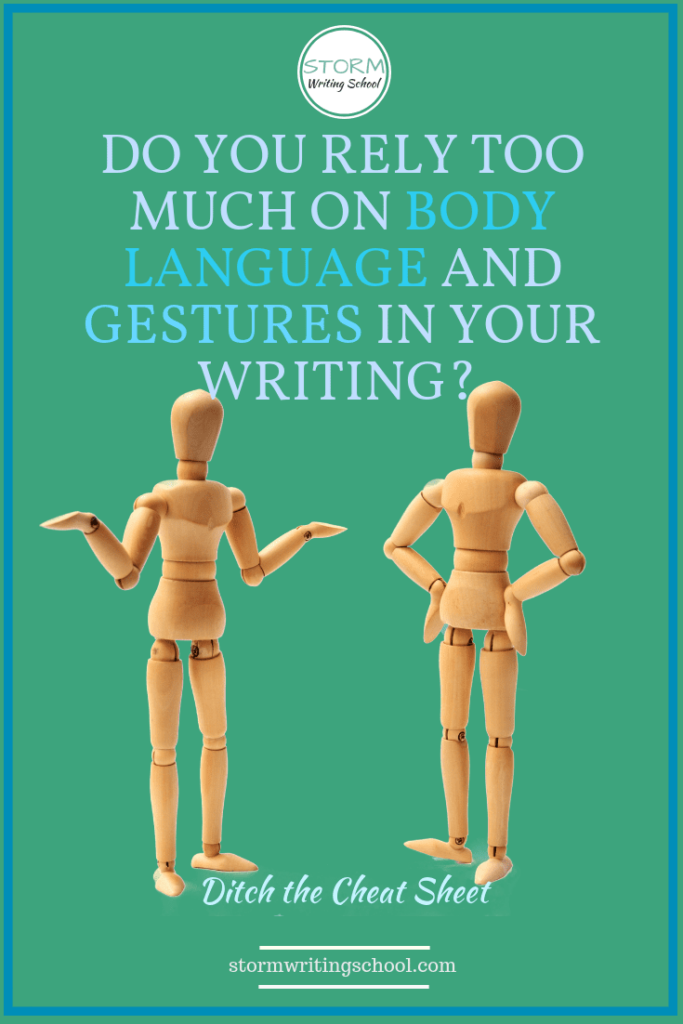Do you describe characters’ body language in order to show their emotions? Do phrases like the following crop up often in your writing?
- His palms were sweating.
- Her heart raced.
- His hands squeezed into fists.
- She raised her eyebrows.
Are there better ways to go about expressing characters’ emotions?

Here’s the train of thought I’d like to take us through in this lesson:
- There’s reason for attempting to write physical expressions of emotion.
- However, such expressions can be problematic.
- And there are often better, more artful ways to give us insights into the interiority of your POV characters.
Stories As a Visual Medium
In his book, From Where You Dream, Robert Olen Butler points out that fiction technique shares a lot in common with cinematic technique. The experience of reading, he says, “is, in fact, a kind of cinema of the inner consciousness.”
When you read a work of literature, the characters and the setting and the action are evoked as images, as a kind of dream in your consciousness.
Indeed, prose storytelling of any kind—nonfiction in addition to fiction—is primarily a visual medium. No matter what medium readers use to consume stories, the brain creates images.
This is the justification for “Show, don’t tell.” Give the reader images. Don’t tell them emotions. Equip readers to co-create the story through the cinema of their inner consciousness.
It’s good advice. But is a character “clenching his jaw” preferable to his “being frustrated”? Is “biting her lip” preferable to her “feeling nervous”?
The Problem with Showing Emotions through Body Language
Here’s the thing: those physical signifiers can sometimes get us in trouble. Though they’re handy ways of depicting emotion (you can find “cheat sheets” out there that give ready-made descriptors for how people display certain emotions through body language), they’re not always the best way.
The problem is that the cheat-sheet descriptors of emotion are so universal and common as to fail to be revelatory. When a character clenches her fists, do you really get a sense of who she is? Is it really that much better than telling us she’s growing frustrated?
In her book Reading Like a Writer, Francine Prose describes picking up a dimestore novel and finding it filled with stock phrases attempting to illuminate character emotion. Her take on such phrases:
Writers cover pages with familiar reactions (her heart pounded, he wrung his hands) to familiar situations. But unless what the character does is unexpected or unusual, or truly important to the narrative, the reader will issue that response without having to be told. On hearing that his business partner has just committed a murder, a man might be quite upset, and we can intuit that without needing to hear about the speed of his heartbeat or the dampness of his palms. On the other hand, if he’s glad that his partner has been caught, or if he himself is the murderer, and he smiles . . . well, that’s a different story.
An Example
Here’s a scene in which the protagonist, 11-year-old Mikey, is at a pool with his older brother Alex. Alex is dating Phoebe, one of the lifeguards, who Mikey finds intimidatingly attractive. Alex tells Mikey he needs some practice talking to girls and basically orders Mikey to go over to the concessions stand and tell Phoebe she’s beautiful.
I crossed my arms. “No way,” I said. “I’m not going to do that.”
“Do it!” Alex stuck his index finger in my face. “Or else.”
“Or else what?”
“Or else I pants you in front of everyone here.”
I froze and stared at him with wide eyes. It wasn’t a question of whether he could do it. Alex was the fastest, strongest kid at the pool, hands down. That’s why girls like Phoebe fell for him. It had nothing to do with how he talked to them.
“I mean it, Mikey. You gotta get out there now or you’re forever gonna be a soft, pudgy loser who spends all his time playing video games and complaining in internet message boards about your involuntary celibacy.”
I narrowed my eyes at him. “What are you talking about?”
“Never mind. Just get over there.” He jerked his chin toward the concessions stand, where Phoebe was scooping an ice cream cone for a first grader.
I took a deep breath and stood up. My palms were sweating. I walked across the pool deck, feeling weak in the knees.
When I got to the concessions stand, Phoebe smiled at me, looking radiant in her red one-piece swimsuit. “Hi. What can I get you?”
“I—” I looked down and away, a blush rising to my cheeks. “I just wanted to say,” I stammered.
Phoebe leaned in, eyebrows up. “Yes?”
“Um.” I looked at her, noticing her striking blue eyes, her long lashes, the smile rising to her lips.
“Wait,” she said, her grin turning mischevious.
“You’re Alex’s little brother!”
I nodded. “Yes.” And suddenly, an idea struck me. A way out. I gasped. “Alex wanted me to tell you,” I said.
She glanced his way, a seductive look in her eyes, then back to me. God, she was stunning.
“Alex wanted me to tell you that you look lovely.”
“Aw!” she said.
“And that you’re really hot. I mean, you look very attractive in your swimsuit. And your skin is so smooth and golden and your hair and your eyes—”
“Wow.” She winked. “I guess he’s really into me.”
This is potentially a very cute scene, but see how the effect of all that body language is to create melodrama? It can feel like reading a poorly-acted scene.
The Takeaways: Alternative Methods
What can you do instead of all this body language cataloguing? How do you render emotion if you’re not allowed to use the body language cheat sheet?
Well, let me be clear: you are allowed to use the cheat sheet. Any resource you find valuable? Hold on to it. Besides, the cheat sheet can sometimes work, especially for characters the reader witnesses from the outside.
But for your perspective characters (the ones whose minds the narrator has access to), put down the cheat sheets and try these other methods.
Context
First of all, the context of the emotion matters a lot. Give us a rich enough context, and we’re likely to feel what the character is feeling anyway. No need to tell us the emotion or “show” it to us through bodily expression. That’s the main point that Prose is making in the quote above when she talks about a man hearing that his business partner has just committed a murder.
Idiosyncrasies
Second, familiar, stock reactions do little to illuminate character. You’re better off describing things that are unique to the character: idiosyncratic tics or habits, unexpected reactions, and meaningful interaction with objects and/or the setting. If we want Mikey feeling embarrased or self-conscious as he walks across the pool deck to the concessions stand, why not have him pinch his own shirtless belly, a reaction to Alex’s insinuation that he’s soft and pudgy?
Empathy
Third—and this is the most important lesson of all—allow readers not just to visualize, but to understand a character’s reaction. In fact, you can often skip the image entirely if you’ve gotten readers to a position of understanding the character’s reaction.
When we can read about a character’s memory or about their speculations of the future or get a sense of the world filtered through their perception—those techniques will get us into their headspace. And sometimes all you need to do is explain where the emotion is coming from rather than what the emotion is or how it is expressed.
In the following excerpt from Brady Udall’s The Lonely Polygamist, 12-year-old Rusty has been caught trying on his sisters’ underwear and tights.
He happened to be wearing some panties over his jeans too, he wanted to see how they looked, kind of like an experiment. They were made of a smooth blue satiny material with a tiny bow on the band and were so small he had a terrible time getting them off. He yanked and pulled and had them down to his ankles when Aunt Beverly walked in and scared him so bad he tipped backward and cracked his head on the edge of the dresser.
Even though his head hitting the dresser had made a noise, and he was now in a lot of pain, Aunt Beverly didn’t say, Are you okay, Rusty, hmm, you want an ice pack or something on that? She just wached him squirm around on the floor trying to stretch the panties around his fee. Rusty thought, Aunt Beverly, you old witchy woman, which made him feel a little less like he might crap his pants in fear.
. . .
Now there was a bunch more girls gathered in the doorway laughing, oh, so insanely happy about what was going on here, it looked like their big white teeth were going to pop out of their mouths. Rusty laughed too, just to show them he understood how funny this underwear situation was, but instead of laughing he snorked, which made them laugh harder, which made his face get hot and itchy.
See how this all comes together? There’s a context that makes shame and embarrassment inevitable; Rusty has some idiosyncratic physical reactions, and we understand his perspective. We get his filtered view of the scene and we know why he laughs back at them. We know he’s ashamed and embarrassed and feeling cornered and getting angry. But we don’t need to be told those abstractions; nor do we need to see the body language that would “show” them.
Beyond the Visual
In short, when you’re trying to convey character emotion—especially POV character emotion—you actually want to capitalize on the ways in which prose storytelling is unlike film. There’s definitely a place for showing rather than telling. But don’t let that limit your imagination or your description of the character’s unique, subjective experience.
For more on techniques for relaying interiority, see my article on “Cat Person,” which delves into specific techniques, or my other articles on interiority. And this article on psychic distance may be a nice supplement here to help clarify why you can get away with some things with non-POV characters that you can’t get away with for your POV characters.
This article is part of the Author Toolbox Blog Hop. To continue hopping through other great blogs in the monthly hop or to join, click here and/or search #AuthorToolboxBlogHop on Twitter and Pinterest (here’s the group board).








20 Responses
Thanks for this. Really interesting. I do feel as if I’m sometimes veering into cliche territory as I’m writing all these ‘shows’ and not ‘tells’. Great ideas here.
Thanks, Dena!
Great post. Sometimes we veer into the cliches without thinking about it twice.
Ronel visiting on Author Toolbox blog hop day: Running Your Author Empire
Yeah, got to be ever-vigilant in the defense against cliches. 🙂
Great post! It’s so hard for new authors to get to a point where they understand that the show-don’t-tell rule is not so cut-and-dry. And I love the idea of digging deeper for ways to show that aren’t so boilerplate. I’m definitely going to refer back to this post.
Thanks, Raimey. Yeah, what I had most fun thinking about is the digging deeper.
You’re not wrong. We do have to put more effort into descriptors to avoid being cliché.
Anna from elements of emaginette
Cliché is always trying to sneak up on us from new angles. 😉
I love this post on “interiority”! You bring up great points that I intuitively knew, but which I rarely see compiled altogether. This is very useful as I prepare for NaNoWriMo. Thank you for sharing!
Thanks, Elle! Glad you found it useful.
Nice in-depth post. Love the examples. There is always so much to think about when writing story. Thanks for sharing.
Thanks, Kristina! There is a lot to think about, isn’t there? You have several novels: any idea how many hours go into each?
An excellent post! I see a lot of blah body language in novels I edit (e.g. she shook her head, he shrugged his shoulders). You’ve got some great tips here on both amping that up … and considering whether we need the body language in the first place.
Thanks, Iola! Yeah, blah body language in a lot of what I edit, too.
“Sometimes cliche is just so … I don’t know. Overlooked,” he said.
So though there is no positive impact on the story, there is no negative impact either. “He said” and “she said” are like that. Sometimes you need them, but don’t overuse them.
An excellent, balanced discussion of a broad problem area! Thank you.
I’m rather less balanced about it with my authors, and typically complain if “body language” is used at any time other than when it’s counter to expectations.
Otherwise you just add an extra layer of decoding, where the reader has to consciously work out what emotional state the author is trying to “show.”
However I take much greater issue with the idea of this ‘inner cinema.’
Great writing isn’t visual. It’s experiential. It evokes and provokes. It stimulates and creates memories; readers learn to simulate, when reading, the sensations of remembered experiences. Granted, sometimes remembering a book feels similar to remembering a movie. But just as a writer must never be fooled by her own metaphors, so she shouldn’t accept an easy analogy between film and text. It isn’t that simple. It’s complex, nuanced and messy.
Well said, Harry. In fact, you state it better than I did in my final section with the subheading “Beyond the Visual.” Writing is experiential rather than just visual. When a writer is attempting to evoke emotion within readers, it’s the non-visual methods of doing so that tend to be the most powerful. A big part of the reason so few film adaptations are better than the book is precisely because the book offers understanding of interiority that isn’t just cinematic.
Great article with some very useful ideas. Thanks!